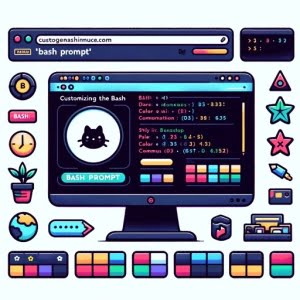Customizing the Bash Prompt: Terminal Layout Guide

Are you looking to add a personal touch to your terminal experience? You’re not alone. Many developers find the default bash prompt a bit mundane and seek ways to make it more informative and visually appealing. Think of the bash prompt as your command line’s personality – it can be as simple or as complex as you want it to be.
Like a chameleon, the bash prompt can change to suit your needs. It can display a variety of information, from your username and hostname to the current directory and time. It can even change colors based on the success or failure of the last command.
This guide will walk you through the process of customizing your bash prompt, from basic changes to advanced modifications. We’ll cover everything from modifying the PS1 environment variable, adding colors and other information, to troubleshooting common issues. So, let’s dive in and start personalizing your bash prompt!
TL;DR: How Do I Customize the Bash Prompt?
Customizing the bash prompt is as simple as modifying the PS1 environment variable. For instance,
PS1='\u@\h:\w$ 'will display the username, hostname, and current directory in your prompt.
Here’s a simple example:
PS1='\u@\h:\w$ '
echo $PS1
# Output:
# user@hostname:current_directory$
In this example, we’ve set the PS1 environment variable to display the username (\u), hostname (\h), and current directory (\w). The echo $PS1 command is used to display the current setting of the PS1 variable, which in this case, would output something like ‘user@hostname:current_directory$’.
This is a basic way to customize the bash prompt, but there’s so much more you can do with it. Continue reading for more detailed information and advanced customization options.
Table of Contents
- Basic Bash Prompt Customization: A Beginner’s Guide
- Advanced Bash Prompt Customization: Colors, Time, and History
- Exploring Third-Party Tools for Bash Prompt Customization
- Troubleshooting Common Bash Prompt Customization Issues
- Bash Prompt Fundamentals: A Deep Dive
- The Bigger Picture: Bash Prompt in Scripts and Projects
- Wrapping Up: Mastering Bash Prompt Customization
Basic Bash Prompt Customization: A Beginner’s Guide
The magic behind bash prompt customization lies in one key environment variable: PS1. This variable defines the primary prompt string, which is displayed whenever Bash is ready to read a new command.
You can see the current value of your PS1 variable by typing echo $PS1 in your terminal.
To modify the PS1 variable, you can simply assign a new string to it. For instance, if you want your prompt to display ‘Hello Bash:’, you can type:
echo $PS1
PS1='Hello Bash: '
echo $PS1
# Output:
# \s-\v\$
# Hello Bash:
In this example, the first echo $PS1 command will output the current setting of the PS1 variable, which by default, is usually set to display the shell name and version (\s-\v\$). After we set the PS1 to ‘Hello Bash: ‘, the second echo $PS1 command now outputs ‘Hello Bash: ‘.
This change is temporary and will only last for the current session. If you open a new terminal window or tab, your prompt will revert to its original state. In a later section, we’ll discuss how to make these changes permanent.
Advanced Bash Prompt Customization: Colors, Time, and History
Once you’ve mastered the basics, you can move on to more advanced customizations. The bash prompt can display a wealth of information, and with a little creativity, you can make it look pretty cool too.
Adding Colors to the Bash Prompt
Colors can make your bash prompt more visually appealing and easier to read. To add colors, you can use special escape sequences in your PS1 string.
Let’s say you want your username to appear in green. You can do this by using the escape sequence \[\033[01;32m\], which represents bold green.
PS1='\[\033[01;32m\]\u@\h:\w$ '
echo $PS1
# Output:
# \[\033[01;32m\]user@hostname:current_directory$
In this example, the \[\033[01;32m\] sequence sets the color to bold green. The \u, \h, and \w sequences represent the username, hostname, and current directory, respectively. The result is a bash prompt with the username displayed in bold green.
Adding Time to the Bash Prompt
You can also add the current time to your bash prompt using the sequence. This can be particularly useful if you want to keep track of how long your commands are taking to run.
PS1=' \u@\h:\w$ '
echo $PS1
# Output:
# hh:mm:ss user@hostname:current_directory$
In this example, the sequence adds the current time (in 24-hour format) to the bash prompt.
Adding Command History Number to the Bash Prompt
Another useful customization is adding the command history number to your bash prompt. This can be done using the \! sequence.
PS1='\! \u@\h:\w$ '
echo $PS1
# Output:
# history_number user@hostname:current_directory$
In this example, the \! sequence adds the command history number to the bash prompt. This can be handy if you often refer back to previous commands.
These are just a few examples of what you can do with advanced bash prompt customization. With a little creativity and experimentation, you can create a bash prompt that’s uniquely yours.
Exploring Third-Party Tools for Bash Prompt Customization
While customizing the bash prompt through the PS1 environment variable offers a lot of flexibility, it can get complicated, especially for complex customizations. This is where third-party tools come in. These tools provide user-friendly interfaces and additional features for customizing the bash prompt, making the process much easier and more efficient.
Powerline: A Statusline Plugin for Bash
Powerline is a popular statusline plugin that can be used with various shell programs, including Bash. It provides a simple and flexible way to customize your bash prompt. With Powerline, you can easily add colors, special symbols, and even display git branch information in your bash prompt.
Here’s how you can install and use Powerline in your bash prompt:
pip install powerline-status
# Add this line to your .bashrc or .bash_profile
. /usr/local/lib/python2.7/dist-packages/powerline/bindings/bash/powerline.sh
# Output:
# Your bash prompt will now display a colorful and informative status line
In this example, we first install Powerline using pip. We then add a line to our .bashrc or .bash_profile that sources the Powerline bash script. This changes our bash prompt to display a colorful and informative status line.
Bash-it: A Bash Framework
Bash-it is a framework for managing your bash configurations. It provides a huge collection of bash commands, aliases, and functions, as well as a system for managing themes, which you can use to easily customize your bash prompt.
Here’s how you can install and use Bash-it to customize your bash prompt:
git clone --depth=1 https://github.com/Bash-it/bash-it.git ~/.bash_it
~/.bash_it/install.sh # keep the default settings during the installation
# Output:
# Your bash prompt will now display a colorful and informative status line
In this example, we first clone the Bash-it repository into our home directory. We then run the install script, which sets up Bash-it and modifies our bash prompt.
Advantages and Disadvantages of Using Third-Party Tools
Third-party tools like Powerline and Bash-it offer a lot of advantages. They make it easy to customize your bash prompt, even for complex customizations. They also provide additional features, like displaying git branch information, that are not available with the default bash prompt.
However, these tools also have some disadvantages. They can be overkill for simple customizations, and they introduce additional dependencies to your system. They can also slow down your bash prompt, especially if you’re using a lot of plugins or features.
In conclusion, whether you should use a third-party tool to customize your bash prompt depends on your needs. If you want a simple and lightweight solution, customizing the PS1 environment variable might be enough. But if you want more advanced features and don’t mind the additional dependencies, third-party tools can be a great option.
Troubleshooting Common Bash Prompt Customization Issues
While customizing the bash prompt can be a fun and rewarding process, it’s not without its challenges. Here, we’ll discuss some common issues you might encounter and how to resolve them.
Special Characters Appearing Literally
One common issue is special characters appearing literally in your bash prompt. This can happen if you forget to escape them with a backslash (\).
For example, if you try to include a dollar sign ($) in your bash prompt without escaping it, Bash will interpret it as a variable.
PS1='Hello$ '
echo $PS1
# Output:
# Hello
In this example, the dollar sign disappears from the bash prompt because it’s interpreted as a variable. To include a literal dollar sign, you should escape it with a backslash (\$).
PS1='Hello\$ '
echo $PS1
# Output:
# Hello$
Colors Not Displaying Correctly
Another common issue is colors not displaying correctly. This can happen if you use the wrong escape sequences or if your terminal doesn’t support the colors you’re trying to use.
If you’re having trouble with colors, make sure you’re using the correct escape sequences. You can find a list of escape sequences for different colors in the Bash Prompt HOWTO.
If your colors are still not displaying correctly, try changing your terminal’s color scheme or using a different terminal that supports more colors.
Changes Not Persisting Across Sessions
If your customizations are not persisting across sessions, it’s likely because you’re not saving them in the right place. Changes to the PS1 variable are only temporary and will be lost when you close your terminal.
To make your changes permanent, you should add them to your .bashrc or .bash_profile file. This file is read every time you start a new bash session, so any changes you make here will be applied automatically.
echo "PS1='\u@\h:\w$ '" >> ~/.bashrc
source ~/.bashrc
# Output:
# The changes to the PS1 variable are now permanent
In this example, we add the PS1 customization to the .bashrc file using the echo command and the >> redirect operator. We then source the .bashrc file to apply the changes immediately.
Remember, troubleshooting is a normal part of any customization process. Don’t be discouraged if things don’t work perfectly the first time. With a little patience and perseverance, you can create a bash prompt that’s uniquely yours.
Bash Prompt Fundamentals: A Deep Dive
Before we delve further into customizing your bash prompt, it’s important to understand what exactly the bash prompt is and some of the related concepts, like environment variables and escape sequences.
What is the Bash Prompt?
The bash prompt, also known as the command prompt, is the area in your terminal where you type commands. It’s called a ‘prompt’ because it ‘prompts’ you for input. By default, the bash prompt displays the username, hostname, and current directory, but as we’ve seen, it can be customized to display a wealth of other information.
Understanding Environment Variables
Environment variables are a way for the shell to store information that can be used by commands. They are named values that can be accessed and modified by the commands you run. The PS1 variable that we’ve been modifying is an example of an environment variable.
You can see all the environment variables in your current session by typing env in your terminal.
env
# Output:
# A list of environment variables and their values
In this example, the env command outputs a list of all the environment variables in the current session and their values.
Decoding Escape Sequences
Escape sequences are special codes that the shell interprets in a certain way. They start with a backslash (\) followed by one or more characters. For example, \u, \h, and \w are escape sequences that represent the username, hostname, and current directory, respectively.
There are many other escape sequences that you can use to customize your bash prompt. You can find a list of them in the Bash Prompt HOWTO.
Understanding these fundamentals is key to mastering bash prompt customization. With this knowledge, you can create a bash prompt that not only looks cool, but also provides useful information and enhances your productivity.
The Bigger Picture: Bash Prompt in Scripts and Projects
Customizing the bash prompt is not just about making your terminal look cool or displaying useful information. It can also play a crucial role in larger scripts or projects. A well-customized bash prompt can provide valuable context and feedback, making your scripts more robust and easier to debug.
For instance, you could customize your bash prompt to display the current git branch when you’re in a git repository. This can be incredibly useful when you’re working on a large project with multiple branches. You could also customize it to change colors based on the success or failure of the last command, providing instant feedback on the status of your script.
# Add this to your .bashrc or .bash_profile
PS1='\u@\h:\w $(git branch 2>/dev/null | grep -e '\* ' | sed 's/^..(.*)/ (\1)/')\$ '
# Output:
# user@hostname:current_directory (git_branch)$
In this example, we’ve added a command substitution ($(command)) to the PS1 variable. This command substitution runs the git branch command, filters the output to get the current branch, and formats it with sed. The result is a bash prompt that displays the current git branch when you’re in a git repository.
Exploring Related Topics: Shell Scripting and Command Line Utilities
Customizing the bash prompt is just one aspect of shell scripting, which is a powerful tool for automating tasks and manipulating data. If you’re interested in learning more about shell scripting, you might want to explore related topics like command line utilities (e.g., grep, awk, sed), control structures (e.g., if, for, while), and process management.
Further Resources for Bash Prompt Customization
If you want to delve deeper into bash prompt customization, here are some resources that you might find useful:
- Bash Prompt HOWTO: This is a comprehensive guide to customizing the bash prompt. It covers everything from basic to advanced customizations, with plenty of examples and explanations.
Powerline on GitHub: This is the official repository for Powerline, a popular statusline plugin for bash and other shell programs. It includes installation instructions, usage examples, and documentation.
Bash-it on GitHub: This is the official repository for Bash-it, a framework for managing your bash configurations. It includes a huge collection of bash commands, aliases, functions, and themes for customizing your bash prompt.
Wrapping Up: Mastering Bash Prompt Customization
In this comprehensive guide, we’ve journeyed through the world of bash prompt customization, understanding how to personalize our terminal experience from the ground up.
We started with the basics, learning how to modify the PS1 environment variable to make simple changes to the bash prompt. We then ventured into more advanced territory, exploring how to add colors, time, command history number, and even git branch information to our bash prompt.
Along the way, we tackled common challenges you might face when customizing the bash prompt, such as special characters appearing literally, colors not displaying correctly, and changes not persisting across sessions. We provided solutions and workarounds for each issue to ensure a smooth customization process.
We also looked at alternative approaches to bash prompt customization, introducing third-party tools like Powerline and Bash-it. These tools offer user-friendly interfaces and additional features, making the customization process much easier and more efficient.
| Method | Flexibility | Ease of Use | Additional Features |
|---|---|---|---|
| PS1 Environment Variable | High | Moderate | Low |
| Powerline | High | High | High |
| Bash-it | High | High | High |
Whether you’re just starting out with bash prompt customization or you’re looking to level up your terminal skills, we hope this guide has given you a deeper understanding of the process and its possibilities.
With the knowledge you’ve gained, you’re now equipped to create a bash prompt that’s not only visually appealing, but also provides useful information and enhances your productivity. Happy customizing!

